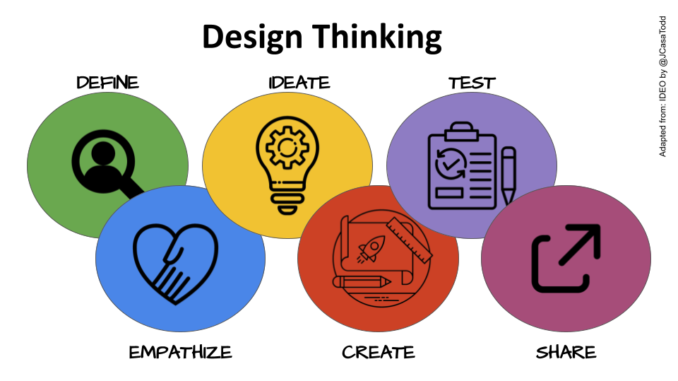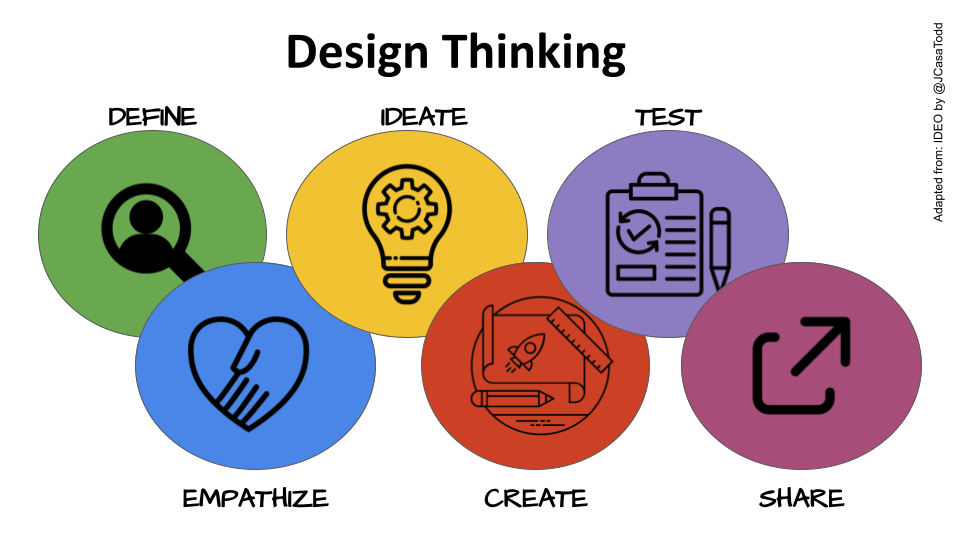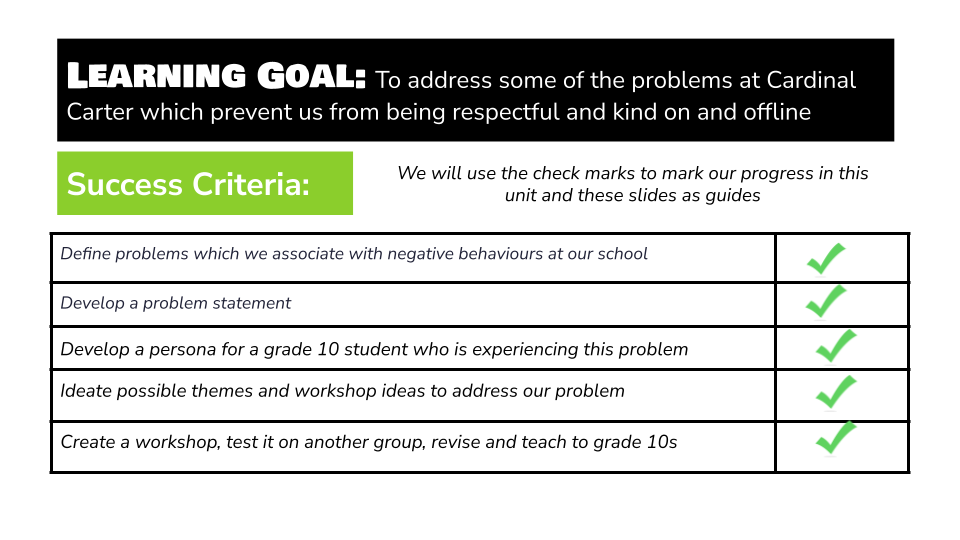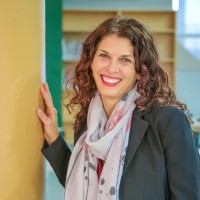
By Jennifer Casa-Todd
One of the Standards of Practice for School Library Learning Commons in Canada is, “Cultivating Effective Instructional Design to Co-plan, Teach and Assess Learning” (CSL 2016-2023) and specifically within the STEM/Maker theme, “Teacher-librarians lead the school and district in design thinking, and thoughtful and collaborative hands-on or experiential projects that address real life problems”. Mostly, in my practice, I have collaborated with Science teachers using the UN Sustainable Development goals as a starting point, asking students in grade 10 science classes to create innovations or campaigns to address climate change. The designs kids have come up with have been really wonderful and the process has been engaging, but the solutions are not often realistic.
This past year, however, I had the opportunity to work with the anti-bullying committee and a leadership teacher to address some of the problems in our own school community. Last year, for the first time, upon my insistence, we had students join the anti-bullying committee. During one of our meetings, our principal asked our opinion about a possible workshop facilitator we could bring into the school to work with grade 9 and 10 students on issues such as cyberbullying and digital wellness. One of the grade 12 student leaders pointedly challenged the idea. “Why would we pay someone to come in when we could create and facilitate the workshops? The kids would listen to us more than they would some random speaker?” And thus began a design thinking project which became one of the most exciting and important units I co-taught last semester.
From the seedling of the idea we formulated a plan. We would ask the teacher teaching the grade 12 leadership class if she was interested in collaborating; she was! We then reached out to teachers of grade 10 classes in a variety of subjects within the Period 4 time slot if they would be interested in having the students facilitate the workshops, and we had teachers in Phys Ed, Religious Education, Civics, and English agree. The first part of this paper explains what we did.
As a reflective educator, I always ask for student feedback at the end of a unit, and I debrief with the co-teacher about what we could have done differently. In the past year, I have been reading more and more about Universal Design for Learning as a vehicle for designing lessons which removes barriers for learning. Thus, in the second half of this paper, I look at the elements of Universal Design for Learning and how I would change the lesson based on its principles. For this part, I rely heavily on the work of my friend and UDL guru, Dr.Katie Novak.
Design Thinking Steps: What We Did
We used the IDEO framework for our design:

Define the Problem
Our students were very adamant that we did not focus on cyberbullying. Instead, they argued that what we needed to do was think about all of the obstacles which prevented students from being upstanders and contributing positively to our school culture. Using that idea as a starting point, we placed students in random groupings and asked them to write down as many problems as they could think of that contribute to bullying, lack of school unity, mean or apathetic behaviour and negative school culture. They did this on a chart paper which was posted on the walls around the classroom. They were then asked to walk around to the lists other group members had posted to add comments, questions or to “upvote” an idea or ideas. Once they did this, groups took their original chart papers down, sat at a table and decided upon the problem they wanted to tackle. They began with, “How might we address the problem of ______at our school?”
Empathize
For this stage, we asked them to create a persona of the grade 10 student who would benefit from their problem statement. They were asked to be as specific as possible. This was so they would understand and develop a sense of caring for their target audience.
Ideate
Typically, the ideate stage would ask students to come up with a broad range of possibilities for how they might solve a problem; in this case, because the product would be a workshop, students brainstormed the best and most memorable lessons they had had in school as well as any ideas they had in terms of resources. We then provided students with a variety of resources we had curated based on their problem statements. Students needed to explore resources and ideas at this stage.
Create
We gave students a three-part lesson plan template and shared the Curriculum expectations for the courses they were going to teach (Civics, Phys Ed, English, and Religious Education). They could use any of the resources we shared or their own ideas.
Test
For this stage, we invited the principal and vice principal to come to our class. Students shared their ideas for feedback. The co-teacher and I also provided feedback and students used our collective feedback to create a slideshow for the lesson itself. They then presented the lesson to a triad to invite further feedback and constructive criticism and to check the timing of the lesson.
Share
Students reached out to the host teacher by email, gathered all of the materials needed for their lesson and set off to facilitate the workshop! They were asked to include an exit ticket as part of their process to see what the grade 10 students took away from their lesson.
Assessment
We had co-constructed a rubric together. We then asked students to give themselves a mark based on the success criteria, reflecting on their own strengths and weaknesses for each strand.
UDL Reflection: What We Could Have Done Better
Universal Design for Learning (UDL) is defined by Higher Education Opportunity Act (PL 110-135) as “a scientifically valid framework for guiding educational practice that (a) provides flexibility in the ways information is presented, in the ways students respond or demonstrate knowledge and skills, and in the ways students are engaged; and (b) reduces barriers in instruction, provides appropriate accommodations, supports, and challenges, and maintains high achievement expectations for all students, including students with disabilities” (Novak & Rodriguez, 2023). The 10 focus areas for UDL include: learning objectives, student identity, social emotional learning, collaboration and community, flexible methods, flexible materials, formative assessments, flexible assessments, self-reflection, and feedback (Novak, 2022). For each of these focus areas, I have delineated how well we addressed the focus area and what we could have done differently.
Learning Objectives
The first focus area for UDL is that “grade-level learning objectives are visible to students and referred to throughout the lesson.” (Novak, 2022). At first glance, I thought I fell in the expert category here.
From the very beginning, students were tasked with addressing problems they thought affected grade 10 students in the school. Once they brainstormed individual problems, they had to narrow down the problem to something they all agreed would make an impact. Throughout the lesson design process, students had to come back to that problem. Both myself and my co-teacher continually asked, how does this address the problem you are trying to solve? We also posted the learning goal and success criteria at the beginning of every lesson.

When it came to our curriculum expectations, however, we could have been more clear about the alignment between the task they were creating and how it connected both to the Leadership curriculum expectations as well as the curriculum of the subject area they were teaching. This would definitely need to be more explicitly incorporated next time.
Student Identity
The second focus area requires that “the learning environment and lesson design affirm the identity of all students” (Novak 2022). This refers to the fact that the resources would honor diverse experiences and proactively fosters student interactions and relationships. In my novice opinion, I think we did this effectively. Because we wanted to model effective lessons for students, we began each lesson with a Minds On activity and/or a community circle. Students were in random groups using playdoh to represent something they could find in common, we placed ideas on paper, scrunched them up, tossed them into the middle of the circle and read the anonymous ideas aloud, we engaged in value lines and fishbowl discussions to express our opinions. Because students identified their own problem statements, they drove the learning in a way that made sense to them and their group.
Social Emotional Learning
This focus area requires that “[t]he learning environment and lesson design addresses the social and emotional needs in the classroom” (Novak, 2022). I will have to admit that this wasn’t really something that we explicitly addressed. We unwittingly helped students self-reflect as part of the process, but we did not build-in coping strategies or provide support for collaboration and teamwork. One of the things students did not like about this assignment, when asked, was that they were not able to pick their own groups. Because we chose their groups, it would be imperative to ensure that we more explicitly support students with conflict resolution strategies as well as strategies for effectively working together.
Collaboration and Community
This focus area focuses on a classroom environment that “fosters engagement, collaboration, and community” (Novak 2022). Truthfully, this class already bonded as a community before I got to work with them; this is a testament to the classroom teacher. Beginning with Minds On lessons helped us meet this focus area, but we could have been more explicit about using group norms. Whenever possible, we tried to randomize students during the Minds On parts of the lesson (line up according to birthday, pick a coloured popsicle stick, use wheel of names, and so on) We also could have provided students with the opportunity to work with additional diverse groupings during the Define and Ideate stages, which I now see as a missed opportunity.
Flexible Methods and Flexible Materials
The learning design provides students with flexibility in how they learn by allowing them to customize their learning experience. Since students chose their own problem and develop their own ideas for how to address this problem, I feel like we were really able to shape their own experience. It was amazing to us how diverse the topics were: Mental Well-being, Cliques, Cancel Culture, Peer Pressure, and Body image. Students also surprised us by incorporating pop culture references and resources from their own experience which we would never have even known to do.
When it comes to Flexible Materials which calls for “flexibility in the scaffolds, strategies, and tools they use as they work toward the learning objectives” (Novak 2022), I think we could have done better here. The resources we curated for students did have some diversity (video, text), but because it was our first time we did not have any exemplars to show them. In retrospect, we could have taken them through a few of the Common Sense Media lessons and gotten their feedback on what they liked or disliked about the lesson. If we do this again, I would show them a few examples of what students came up with so students can see how much flexibility they can incorporate in their own lessons. .
Formative Assessments and Flexible Assessments
The formative assessments focus area suggests that data is used to frame feedback and target instruction which I think we did very well through the test stage. Students used the descriptive and specific feedback we gave them to make changes to their workshops. They also used peer feedback and constructive criticism to improve their lessons. Every class consisted of a Minds On activity (15 minutes) and then individual conferencing with students during which we were able to support students who were struggling and provide additional ideas to students who were flourishing.
Flexible assessments refer to the fact that assessments are flexible allowing students’ options for how they share their skills, thoughts and ideas (Novak, 2022). Truthfully, this could have been vastly improved. Did students with strong writing skills get higher marks? I don’t think so, since we did conference with students, but reflecting on this UDL focus area made me wonder why instead of just asking students for a written rubric, they could have shared their strengths, weaknesses and mark with us via a video or audio?
Self-Reflection and Feedback
I have combined the final two focus areas. Self-reflection refers to explicit opportunities for students to reflect on the choices they made as well as their final product. Feedback refers to both formal and informal opportunities to give input of the lesson and suggest improvements. In our end of unit reflection Google Form, we asked students the following:
- One thing you are proud of
- One thing you would have done differently
- What did you learn about yourself and your leadership style in this unit?
- Keep it, Ditch It, Tweak it: What elements of this project would you keep, what would you remove, and what would you change? Explain.
The answers were sometimes difficult to read and sometimes heart-warming but in every case they were definitely enlightening and provided a really wonderful opportunity to debrief and reflect with my co-teacher.
I am looking forward to the opportunity to try this design thinking lesson out with another teacher this school year, while explicitly implementing a more UDL specific approach.
References
Canadian School Libraries (2016-2023). Leading Learning: Standards of Practice for
School Library Learning Commons in Canada. Available: http://llsop.canadianschoollibraries.ca
Cast. (2022, October 2). . Universal Design for Learning Guidelines. Retrieved August
26, 2023, from https://udlguidelines.cast.org/
Novak, K. (2022, August 31). 10 Focus Areas to Evaluate the Effectiveness of UDL in
the Classroom. Novak Education. Retrieved August 26, 2023, from https://www.novakeducation.com/blog/10-udl-observations-in-the-classroom
Novak, K., & Rodriguez, K. (2023, June 15). Universal Design for Learning and Equity.
Edutopia. Retrieved August 28, 2023, from https://www.edutopia.org/article/universal-design-learning-promotes-equity/

Jennifer Casa-Todd is a mom, wife, teacher-librarian, author, keynote speaker, Google Certified trainer and Innovator as well as an ISTE Community leader and GEG Ontario leader.. She is the recipient of the ISTE Digital Citizenship PLN Award (2020) and the YSCPC award for teaching excellence (2023). Jennifer is passionate about showing people how they can use technology and social media to make the world a better place.